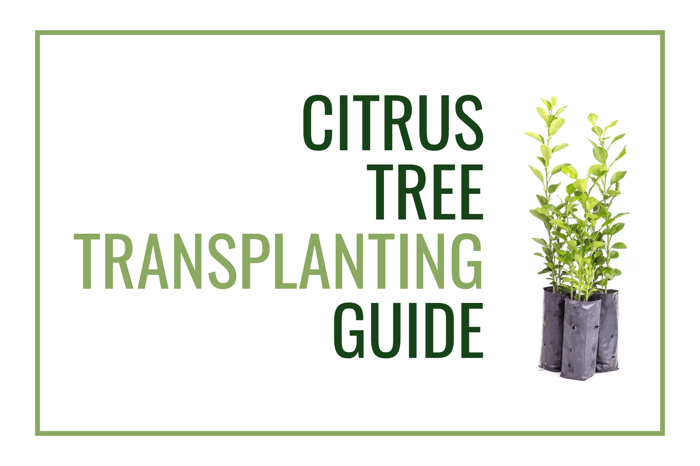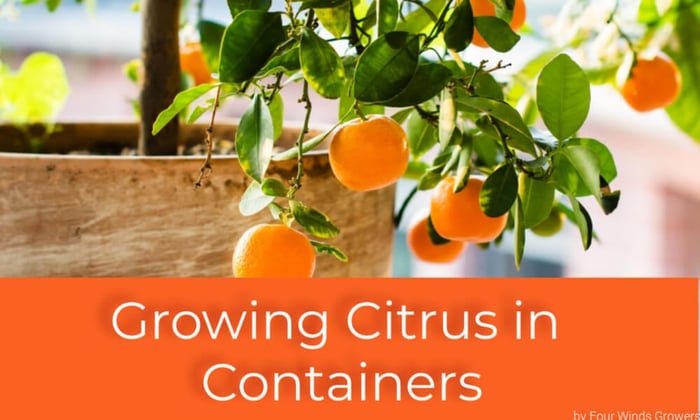Transplanting our primo size citrus trees into bigger pots or containers is a simple process. The compact size fits well in a variety of pots or can be planted in the ground. Here is our transplanting guide to get you started.
Citrus Trees originated in subtropical and tropical regions of Asia. This and the need to protect them from deadly diseases like HLB requires them to be propagated in screened greenhouses that provide the heat, humidity, and protection they need. This does not mean that home growers need to grow them in greenhouses, but it does mean that you need to acclimate citrus trees to your climate before you plant your tree. This guide will cover a wide variety of citrus trees including Oranges, Lemons, Calamansi, Limes, Kumquats, Mandarins, and Grapefruits.
Step 1: Acclimate
After you have unboxed your tree you need to remove the plastic bag used to prevent soil from spilling during shipping. Now, because all citrus are required to be greenhouse propagated to protect them from harmful diseases, it will shock the tree if you plant it in direct sunlight right away. The ideal location for the first week outside is a spot by the house with indirect sunlight that gets an hour or two of direct light throughout the day. After a week or two, you can move your adjusted tree into its final location, which ideally gets 8 hours of full sun daily. If you are growing in a container, feel free to pot your tree up and follow the steps above during the transition period.
Note: It is common for citrus trees to drop some of their leaves during this transition. Do not panic. Monitor the temperature outside and don’t hesitate to bring the tree inside if you see that temperatures are going below 40°F.
Step 2: Materials
The most important part is to start with a healthy tree. Our site has over 60 varieties of citrus trees to choose from and we ship to almost every state except Texas, Arizona, Alabama and Florida. Our trees can also be found in garden centers all over California.
Primo-sized citrus, avocado, fig, and pomegranate trees are grown in 5x12" growers pots. For these trees, an adequate-sized pot is 12” in diameter and 14” deep (#5 container). You will need a pot with adequate drainage. Drilling holes in the bottom of your plastic or wood containers is a quick and easy solution if you find a pot that you like that may not have enough drainage.
For container planting, the ideal soil mix is a chunky mix like cactus or orchid mix. We recommend our DIY Primo Potting Mix. For in-ground planting, prepare a 50/50 mix of native soil and an appropriate potting mix.
Step 3: Location
Container growing- Regardless of container or in-ground growing, Citrus needs a warm, wind-free space with 8 or more hours of direct sunlight per day to thrive. For trees kept indoors during the winter months, place your tree in a south-facing window to get the most sun. If the hours of direct sunlight fall below 6 hours, then you may want to consider supplementing with grow lights.
In-Ground- Prepare Primo sized trees as follows: First, choose an area in your yard that gets at least 6 but preferably 8 or more hours of sunlight each day. If you live in a really hot climate, we recommend painting the trunk and any branches that may be exposed to direct light with Plant Guard to protect them from sunburn and more. Then determine whether you have hard clay soil or well-draining sandy soil.
To test your drainage, dig a hole 30" deep where you would like to place the tree. Fill with water to saturate the soil. The next day, refill it with water. Your drainage is adequate if the water level drops 2" in two hours. If the water does not drain well, we recommend digging a large hole and filling it back in, half with the best of the original soil, and half with a good-quality amendment mix to ensure good drainage. If your soil is too hard it may be easier to prepare an above-ground garden bed.
Step 4: Planting
Once you receive the tree you must remove the plastic bag used to prevent soil from spilling during shipping. Citrus trees are best planted during the active growing season. In summer it is best to plant in the early morning hours when temperatures are cool to moderate. Try to keep the roots out of the sun as much as possible. Water the tree thoroughly after transplanting. You may wish to pinch off fruit and blossoms for the first year or two after a new planting to encourage stronger root and branch development.
Containers- Our trees are shipped in a 4" x 9.5" or 5" x 12" nursery tree pot depending on size. These tree sizes are best re-potted into a 10" or 12" container within a month of delivery. Do not plant into a too-large container, as it can cause problems later. Too much unused soil retains moisture, leading to the deterioration of the tiny hair roots.
Add prepared citrus soil mix to the bottom of your new container. Gently slide tree roots out of the old container, trimming off any dead roots and detangling any circling roots so that growth into the new pot will not be impeded. Place the loosened root mass into the new container and gently fill with your fresh planting mix, packing down lightly to remove large air spaces from the root zone. The top of the roots should be just beneath the soil surface, and crown roots (root collar area) should show above the soil line. Make sure that soil or mulch is not pushed up against the trunk of the tree. Water deeply. Stake loosely with a tie if needed. It is a good idea to repot every year or so, or when you see roots peeking through drainage holes.
In-Ground-
Soils rich in humus are best. For heavy or poor soils, we recommend digging a large hole and filling it back in, half with the best of the original soil, and half with a good-quality amendment mix.
Start by making a 12" x 12" hole in your newly amended soil. Gently invert the pot to remove the tree with the soil intact. Somewhat dry trees will usually release more easily from the pot for transplanting. Squeezing the sides of a plastic pot can help to loosen the soil and roots. Take note of the abundant fibrous root system. Straighten out any circling roots and cut off any broken or dead roots before planting. Amend your planting hole as described above. Do not add fertilizer to the soil while backfilling your hole; however, you can apply some to the soil surface after planting.
Plant your tree so that the top of the root ball is just shy of the soil surface. Backfill with soil, being sure to tamp soil lightly as you go and water thoroughly after planting to eliminate any large air pockets. Stake the tree as needed until well-established. Green plant ties are a good choice for tying trees to stakes. An optional step of adding a hefty 3-4" layer of mulch around your tree will help with water retention. Be sure to keep all mulches you may add at least 6" away from the trunk.
Check out Growing Citrus for more information!
Author: Israel Osuna




